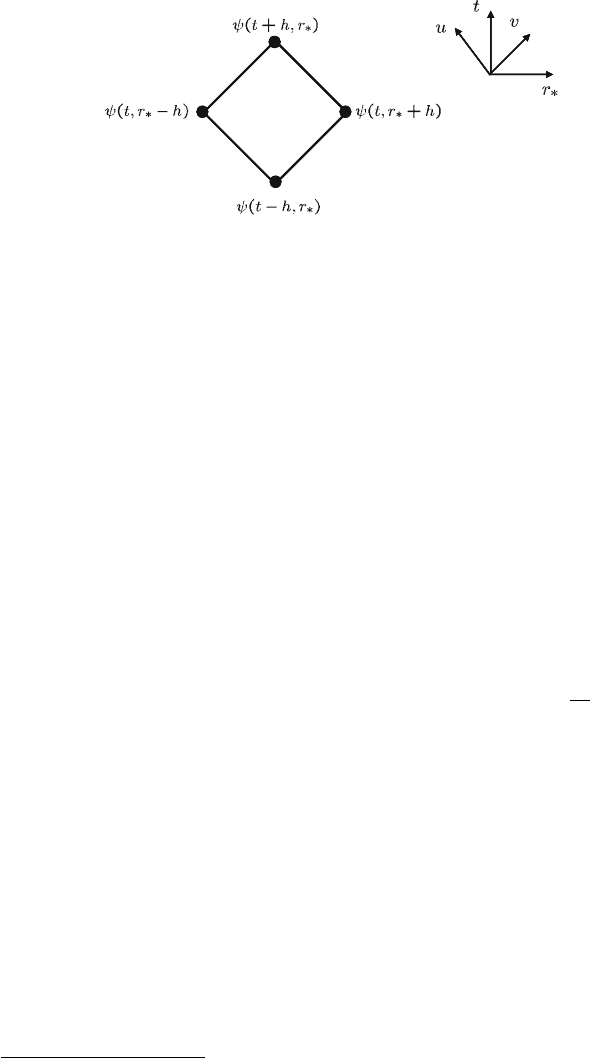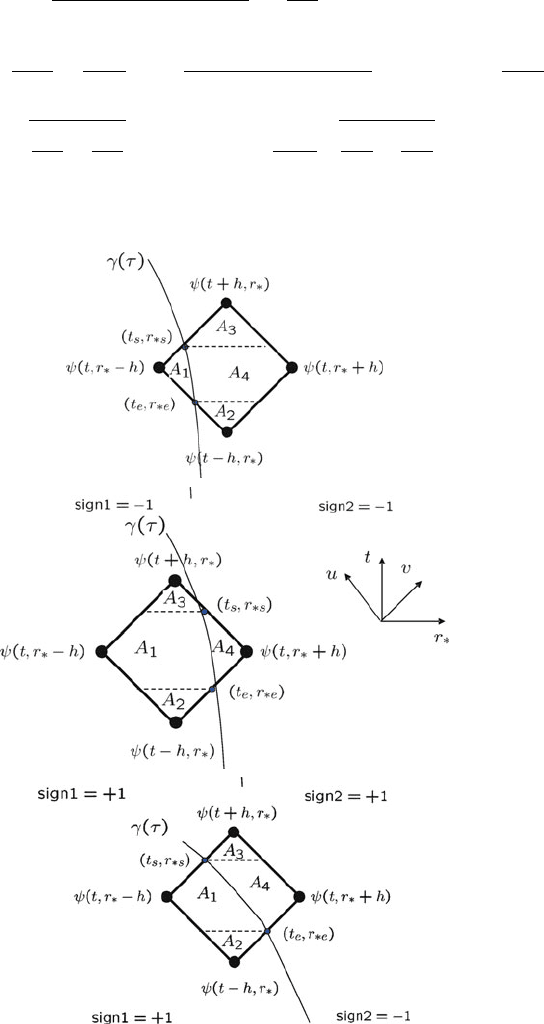Blanchet L., Spallicci A., Whiting B. (Eds.) Mass and Motion in General Relativity
Подождите немного. Документ загружается.


Free Fall and Self-Force: an Historical Perspective 571
Four types of measurements can be envisaged: local measurement of time dT,
non-local measurement of time dt, local measurement of length dR, non-local mea-
surement of length dr. Locality is somewhat a loose definition, but it hints at those
measurements by rules and clocks affected by gravity (of the SD black hole) and
noted by capital letters T;R, while non-locality hints at measurements by rules and
clocks not affected by gravity (of the SD black hole) and noted by small letters
t;r.
12
Therefore, for determining (velocities and) accelerations, four possible com-
binations do exist:
Unrenormalised acceleration d
2
r=dt
2
Semi-renormalised acceleration d
2
R=dt
2
Renormalised acceleration d
2
R=dT
2
Semi-renormalised acceleration d
2
r=dT
2
The latter has not been proposed in the literature and discussion will be limited to the
first three types. The former two present repulsion at different conditions, while the
third one never presents repulsion.
The first to introduce the idea of gravitational repulsion was Droste [65,66]him-
self. He defines:
dR D
dr
r
1
2M
r
; (14)
which, after integration, Droste called the distance ı from the horizon. This quantity
is derived from the SD metric posing dt D0, delicate operation since the relation
between proper and coordinate times varies in space as explained by Landau and
Lifshits [114]; thus it may be accepted only for a static observer (obviously the no-
tion of static observer raises in itself a series of questions; see e.g. Doughty [62],
Taylor and Wheeler [198]). Through a Lagrangian and the relation of Eq. 14,forra-
dial trajectories Droste derives that the semi-renormalised velocity and acceleration
are given by (A is a constant of motion, equal to unity for a particle falling with zero
velocity at infinity):
dR
dt
D
s
1
2M
r
1 A C
2AM
r
; (15)
d
2
R
dt
2
D
M
r
2
2
6
6
4
r
1
2M
r
2.dR=dt/
2
r
1
2M
r
3
7
7
5
D
M
r
2
1 2A C
4AM
r
r
1
2M
r
;
(16)
12
This definition is not faultless (there is no shield to gravity), but it is the most suitable to describe
the debate, following Cavalieri and Spinelli [31,32, 193] and Thirring [199].

572 A. Spallicci
where the constant of motion A is given by:
A D
1
2M
r
1
.dr=dt/
2
1
2M
r
3
:
From Eq. 16, two conditions may be derived for the semi-renormalised accelera-
tion, for either of which the repulsion (the acceleration is positive) occurs for A D 1
if r<4Mor else dR=dt >
p
1=2
p
1 2M=r.
Instead in his thesis [65], Droste investigated the unrenormalised velocity accel-
eration and for zero velocity at infinity, they are:
dr
dt
D
1
2M
r
r
2M
r
; (17)
d
2
r
dt
2
D
M
r
2
2
6
4
1
2M
r
3.dr=dt/
2
1
2M
r
3
7
5
D
M
r
2
1
2M
r
1
6M
r
; (18)
for which repulsion occurs if, still for a particle falling from infinity with zero initial
velocity, r<6Mor else dr=dt > 1=
p
3.1 2M=r/.
The impact of the choice of coordinates on generating repulsion was not well
perceived in the early days of general relativity. Further, many notable authors as
Hilbert [102, 103], Page [157], Eddington [70], von Laue [205]intheGerman
original version of his book, Bauer [24], de Jans [52–54] although indirectly by
referring to the German version of [205], arrive independently and largely ignoring
the existence of Droste’s work, to the same conclusions in semi-renormalised or
unrenormalised coordinates.
The initial conditions
13
may astray the particle from being attracted by the gravi-
tating mass. Indeed, Droste [66] and Page [157] refer to particles having velocities at
infinity equal or larger than 1=
p
2 for the semi-renormalised coordinates and equal
or larger than 1=
p
3 for the unrenormalised coordinates. These conditions dictate to
Droste and Page that the particle is constantly slowed down when approaching the
black hole and therefore impose to gravitation an endless repulsive action.
13
Generally, the setting of the proper initial conditions may be a delicate issue e.g. when associ-
ated with an initial radiation content expressing the previous history of the motion as it will be later
discussed; or, in absence of radiation, when an external (sort of third body) mechanism prompt-
ing the motion to the two body system is to be taken into account. The latter case is represented by
the thought experiment conceived by Copperstock [39] aiming to criticise the quadrupole formula.
The experiment consisted in two fluid balls assumed to be in static equilibrium and held apart by
a strut, with membranes to contain the fluid, until time t D 0. Between t D 0 and t D t
1
,the
strut and the membranes are dissolved and afterwards the balls fall freely. Due to the static initial
conditions, there is a clear absence of incident radiation, but the behaviour of the fluid balls in the
free fall phase depends on how the transition from the equilibrium to the free fall takes place. This
initial dependence obscured the debate on the quadrupole formula.

Free Fall and Self-Force: an Historical Perspective 573
In the later French editions of his book, von Laue [205] writes the radial geodesic
in proper time, but it is only in 1936 that Drumaux [67] fully exploits it. Drumaux
criticises the use of the semi-renormalised velocity and considers Eq. 14 as defining
the physical measurement of length dR. Similarly, the relation between coordinate
and proper times (for dr D 0) provides the physical measurement of time dT:
dT D
r
1
2M
r
dt: (19)
Thereby, Drumaux derives the renormalised velocity and acceleration in proper
time:
dR
dT
D
r
2M
r
; (20)
d
2
R
dT
2
D
M
r
2
r
1
2M
r
; (21)
for which no repulsion occurs. This approach is followed by von Rabe [206],
Whittaker [210], Srinivasa Rao [194], Zel’dovich and Novikov [216]. Nevertheless,
McVittie, almost 30 years after Drumaux [143], still reaffirms that the particle is
pushed away by the central body as do Treder [201], also in cooperation with Fritze
[202], Markley [138], Arifov [9, 10], McGruder [142]. A discussion on radar and
Doppler measurements with semi-renormalised measurements was offered by Jaffe
and Shapiro [107, 108]. The controversy seems to be extinguished in the 1980s,
although recent research papers still refer to it, e.g. Kutschera and Zajiczek [112].
For the particle’s velocity at the horizon, another, though related, debate has taken
place in some of the above mentioned references as well as in Landau and Lifshits
[114], Baierlein [12], Janis [109, 110], Rindler [170], Shapiro and Teukolsky [182],
Frolov and Novikov [85], Mitra [151], Crawford and Tereno [40], M¨uller [153]the
last ones being recently published. Whether the velocity is c or less, it is still the
question posed by these papers.
The further step forward in the analysis of a freely falling mass into an SD black
hole has taken place in the period from 1957 to 1997. In these 40 years,
14
the falling
mass finally radiates energy (the radiated gravitational power is proportional to the
square of the third time derivative of the quadrupole moment which is different than
zero), but its motion is still unaffected by the radiation emitted. The influence of the
radiation on the motion of a particle of infinitesimal size was not dealt with until
1997.
14
Free fall has also been studied in other contexts. Synge [196] undertakes a detailed investigation
of the problem and shows that, actually, the gravitational field (i.e. the Riemann tensor) plays an
extremely small role in the phenomenon of free fall and the acceleration of 980 cm/s is, in fact, due
to the curvature of the world line of the tree branch. The apple is accelerated until the stem breaks,
then the world line of the apple becomes inertial until the ground collides with it.

574 A. Spallicci
5 Black Hole Perturbations
Perturbations were first dealt with by Regge and Wheeler [167, 168], where an SD
black hole was shown to regain stability after undergoing small vibrations about its
spherical form, if subjected to a small perturbation.
15
The analysis was carried out
thanks to the first application to a black hole of the Einstein equation at higher order.
The SD metric describes the background field g
on which the perturbations
h
arise. It is given by:
ds
2
D
1
2M
r
dt
2
C
1
2M
r
1
dr
2
C r
2
d
2
C sin
2
d
2
: (22)
Equation 22 originates from the Einstein field equation in vacuum, consisting in the
vanishing of the Ricci tensor R
D 0.
Instead, the Regge–Wheeler equation derives from the vacuum condition, but this
time posed on the first order variation of the Ricci tensor ıR
D 0. The generic
form of the variation of the Ricci tensor was found by Eisenhart [75] and it is given
by ıR
Dı
ˇ
Iˇ
C ı
ˇ
ˇ I
where the tensor ı
˛
ˇ
, variation of the Christoffel
symbol (a pseudo-tensor), is: ı
˛
ˇ
D 1=2 g
˛
.h
ˇI
C h
Iˇ
h
ˇI
/,beingthe
perturbation h
D ıg
. Replacing the latter in the vanishing variation of the
Ricci tensor, a system of ten second order differential equations in h
was ob-
tained. Exploiting spherical symmetry, finally Regge and Wheeler got a vacuum
wave equation out of the three odd-parity equations giving birth to a field that has
grown immensely from the end of the 1950s.
16
Zel’dovich and Novikov [215] first considered the problem of gravitational waves
emitted by bodies moving in the field of a star, on the basis of the quadrupole for-
mula, thus at large distances from the horizon, where only a minimal part of the
radiation is emitted.
While a less known semi-relativistic work by Ruffini and Wheeler [178, 179]
appeared in the transition from the 1960s to the 1970s, it was the work by Zerilli
[218–220], where the source of perturbations was considered in the form of a
radially falling particle, that opened the way to study free fall in a fully, al-
though linearised, relativistic regime at first order. The Zerilli equation rules
even-parity waves in the presence of a source, i.e. a freely falling point particle,
15
For a critical assessment of black hole stability, see Dafermos and Rodnianski [44].
16
A well-organised introduction, largely based on works by Friedman [84] and Chandrasekhar
[33], is presented in the already mentioned book by the latter [34]. Some selected publications
geared to the finalities of this chapter are to be listed: earlier works by Mathews [141], Stachel
[195], Vishveshvara [204]; the relation between odd and parity perturbations [35]; the search for a
gauge invariant formalism by Martel and Poisson [140] complements a recent review on gauge in-
variant non-spherical metric perturbations of the SD black hole spacetimes by Nagar and Rezzolla
[154]; a classic reference on multiple expansion of gravitational radiation by Thorne [200]; the
derivation by computer algebra by Cruciani [41, 42] of the wave equation governing black hole
perturbations; the numerical hyperboloidal approach by Zenginon˘glu [217].

Free Fall and Self-Force: an Historical Perspective 575
generating a perturbation for which the difference from the SD geometry is small.
The energy–momentum tensor T
is given by the integral of the world-line of
the particle, the integrand containing a four-dimensional invariant ı Dirac distri-
bution for the representation of the point particle trajectory. The vanishing of the
covariant divergence of T
is guaranteed by the world-line being a geodesic in the
background SD geometry; in this way, the problem of the linearised theory on flat
spacetime (for which the particle moves on a geodesic of flat space that determines
uniform motion and thereby without emission of radiation) is avoided. Finally, the
complete description of the gravitational waves emitted is given by the symmetric
tensor h
, function of r, , and t.
The formalism can be summarised as follows [218–220].
17
Due to the spherical
symmetry of the SD field, the linearised field equations for the perturbation h
are in the form of a rotationally invariant operator on h
, set equal to the energy–
momentum tensor also expressed in spherical tensorial harmonics:
QŒh
/ T
Œı.z
u
/; (23)
where the ı.z
u
/ Dirac distribution represents the point particle on the unperturbed
trajectory z
u
.
The rotational invariance is used to separate out the angular variables in the field
equations. For the spherical symmetry on the 2-dimensional manifold on which t;r
are constants under rotation in the ; sphere, the ten components of the perturbing
symmetric tensor transform like three scalars, two vectors and one tensor:
h
tt
;h
tr
;h
rr
.h
t
Ih
t
/; .h
r
Ih
r
/
h
h
h
h
:
In the Regge–Wheeler–Zerilli formalism, the even perturbations (the source term
for the odd perturbations vanishes for the radial trajectory, and given the rotational
invariance through the azimuthal angle, only the index referring to the polar or lati-
tude angle survives), going as .1/
l
, are expressed by the following matrix:
h
D
0
B
B
B
B
B
B
@
1
2M
r
H
0
YH
1
Yh
0
Y
;
h
0
Y
;
sym
1
2M
r
1
H
2
Yh
1
Y
;
h
1
Y
;
sym sym r
2
KY C GY
;
r
2
G
Y
;
cot Y
;
sym sym sym r
2
sin
2
K CG
Y
;
sin
2
Ccot Y
;
1
C
C
C
C
C
C
A
;
(24)
17
Two warnings: the literature on perturbations and numerical methods is rather plagued by edito-
rial errors (likely herein too...) and different terminologies for the same families of perturbations.
Even parity waves have been named also polar or electric or magnetic, generating some confusion
(see the correlation table, Table II, in [220]). Sago, Nakano and Sasaki [180] have corrected the
Zerilli equations (a minus sign missing in all right-hand side terms) but introduced a wrong defini-
tion of the scalar product leading to errors in the coefficients of the energy-momentum tensor.

576 A. Spallicci
where H
0
;H
1
;H
2
;h
0
;h
1
;K;G are functions of .t; r/ and the l multipole index is
not displayed. After angular dependence separation, the seven functions of .t; r/ are
reduced to four due to a gauge transformation for which G D h
0
D h
1
D 0,i.e.the
Regge–Wheeler gauge.
For a point particle of proper mass m, represented by a Dirac delta distribution,
the stress-energy tensor is given by:
T
˛ˇ
D m
u
˛
u
ˇ
u
0
r
2
ıŒr z
u
.t/ı
2
Œ˝; (25)
where z
u
.t/ is the trajectory in coordinate time and u
˛
is the 4-velocity.
Any symmetric covariant tensor can be expanded in spherical harmonics [218].
For radial fall it has been shown that only three even source terms do not vanish
and that two functions of .t; r/ become identical. Finally, six equations are left with
three unknown functions H
0
D H
2
;K;H
1
. After considerable manipulation, the
following wave equation is obtained:
@
2
l
.t; r/
@r
2
@
2
l
.t; r/
@t
2
V
l
.r/
l
.t; r/ D S
l
.t; r/; (26)
where r
D r C 2M ln.r=2M 1/ is the tortoise coordinate; the potential V
l
.r/ is
given by:
V
l
.r/ D
1
2M
r
2
2
. C 1/r
3
C 6
2
Mr
2
C 18M
2
r C 18M
3
r
3
.r C 3M /
2
;
being D1=2.l 1/.l C2/. The source S
l
.t; r/ includes the derivative of the Dirac
distribution (denoted ı
0
), coming from the combination of the h
and their deriva-
tives
18
:
S
l
D
2.r 2M /
r
2
. C 1/.r C 3M /
r.r 2M /
2u
0
ı
0
Œr z
u
.t/
r. C 1/ 3M
2u
0
3M u
0
.r 2M /
2
r.r C 3M /
ıŒr z
u
.t/
; (27)
for u
0
D1=.1 2M=z
u
/ being the time component of the 4-velocity and
D4m
p
.2l C 1/. The geodesic in the unperturbed SD metric z
u
.t/ assumes
different forms according to the initial conditions
19
; herein, the simplest form is
18
There is an editorial error, a numerical coefficient, in the corresponding expressions (2.16) in
[133]and(2.8)in[134], which the footnote 1 at page 3 in [139] does not address.
19
For a starting point different from infinity or a non-null starting velocity, but not their combina-
tion, see Lousto and Price [133–135], Martel and Poisson [139].

Free Fall and Self-Force: an Historical Perspective 577
given, namely zero velocity at infinity. Then, z
u
.t/ is the – numerical – inverse
function of:
t D4M
z
u
2M
1=2
4M
3
z
u
2M
3=2
2M ln
2
6
6
4
r
z
u
2M
1
r
z
u
2M
C 1
3
7
7
5
: (28)
The coordinate velocity Pz
u
of the particle may be given in terms of its position z
u
:
Pz
u
D
1
2M
z
u
2M
z
u
1=2
: (29)
The dimension of the wavefunction is such that the energy is proportional to
R
1
0
P
2
dt. The wavefunction, in the Moncrief form [152] for its gauge invariance,
is related to the perturbations via:
l
.t; r/ D
r
C 1
"
K
l
C
r 2M
r C 3M
H
l
2
r
@K
l
@r
!#
; (30)
where the Zerilli [219] normalisation is used for
l
. For computations, this allows
the choice of a convenient gauge, like the Regge–Wheeler gauge. The inverse re-
lations for the perturbation functions K, H
2
, H
1
are given by Lousto [129, 132]:
K D
6M
2
C 3M r C . C 1/r
2
r
2
.r C3M /
C
1
2M
r
;r
u
0
.r 2M /
2
. C 1/.r C 3M /r
ı;
(31)
H
2
D
9M
3
C 9M
2
r C 3
2
Mr
2
C
2
. C1/r
3
r
2
.r C 3M /
2
C
3M
2
M r Cr
2
r.r C 3M /
;r
C.r 2M /
;rr
C
u
0
.r 2M /Œ
2
r
2
C 2M r 3M r C 3M
2
r. C 1/.r C 3M /
2
ı
u
0
.r 2M /
2
. C 1/.r C 3M /
ı
0
; (32)
H
1
D
r
2
3M r 3M
2
.r 2M / .r C 3M /
;t
Cr
;tr
u
0
:
z
u
.r C M/
. C 1/.r C 3M /
ıC
u
0
:
z
u
r.r 2M /
. C 1/.r C 3M /
ı
0
:
(33)
Several works by Davis, Press, Price, Ruffini and Tiomno [47–49, 175–177],
but also by individual scholars like Chung [36], Dymnikova [68] and the forerun-
ners of the Japanese school as Tashiro and Ezawa [197], Nakamura with Oohara and
Koijma [155] or with Shibata [184], appeared in the frequency domain in the 1970s

578 A. Spallicci
and fewer later on, analysing especially the amplitude and the spectrum of the ra-
diation emitted. Haugan, Petrich, Shapiro and Wasserman [100, 158, 183] modeled
the source as a finite-sized star of dust.
For an infalling mass from infinity at zero velocity, the energy radiated to infinity
for all modes [48] and the energy absorbed by the black hole [49] for each single
mode, and for all modes
20
are given by respectively (beware, in physical units):
X
l
E
r
l
D 0:0104
m
2
c
2
M
;E
a
l
D 0:25
m
2
c
2
M
;
X
l
E
a
l
D
8
mc
2
; (34)
while most of the energy is emitted below the frequency:
f
m
D 0:08
c
3
GM
: (35)
Up to 94% of the energy is radiated between 8M and 2M and 90%ofitinthe
quadrupole mode.
Unfortunately, the analysis in the frequency domain does not contribute much
to the understanding of the particle motion, the limitation having origin in the ab-
sence of exact solutions. A Fourier anti-transform of an approximate solution, for
instance valid at high frequencies, does not reveal which effect on the motion has
the neglect of lower frequencies. Thus, the lack of availability of any time domain
solution has impeded progress in the comprehension of motion in the perturbative
two-body problem. Although studies on analytic solutions were attempted through-
out the years, e.g. Fackerell [78], Zhdanov [221], Leaver [117–119], Mano, Suzuki
and Takasugi [137]andFiziev[82], they were limited to the homogeneous equation.
6 Numerical Solution
The breakthrough arrived thanks to a specifically tailored finite differences method.
It consists of the numerical integration of the inhomogeneous wave equation in time
domain, proposed by Lousto and Price [134, 135] and based on the mathematical
formalism of the particle limit approximation developed in [133] in the Eddington–
Finkelstein coordinates [71,81]. A parametric analysis of the initial data by Martel
and Poisson has later appeared [139]. Confirmation of the results, among which the
waveforms at infinity, is contained in [5].
The grid cells are separated in two categories, according to whether the cell
is crossed or not by the particle. The latter category, Fig. 1, is then formed by the
cells for which r ¤ z
u
.t/ and the .t;r/ evolution is not affected by the source.
20
The divergence in summing over all l modes is said to be taken away by considering a finite size
particle [49].

Free Fall and Self-Force: an Historical Perspective 579
Fig. 1 An empty cell never crossed by the particle world-line
It is then sufficient to integrate each term of the homogeneous wave equation. The
wave operator allows an exact integration (passing to the r
tortoise coordinate):
“
Cell
@
2
r
@
2
t
dA D4Œ.t C h; r
/ C.t h; r
/
.t;r
C h/ .t;r
h/: (36)
Instead, the product potential-wavefunction is given by:
“
Cell
V.r/dA D V.r/h
2
Π.t C h; r
/ C .t h; r
/ C .t;r
C h/
C.t;r
h/ C O.h
3
/: (37)
The evolution algorithm defines at the upper cell corner as computed out of
the three preceding values:
.t C h; r
/ D.t h; r
/ C
.t;r
C h/ C .t;r
h/
1
h
2
2
V.r/
:
(38)
For the cells crossed by the particle, a different integration scheme is imposed
(Fig. 2). The product potential-wavefunction is given by:
“
Cell
V.r/dA D V.r/
A
3
.t C h; r
/ C A
2
.t h; r
/ C A
4
.t;r
C h/
CA
1
.t;r
h/ C O.h
3
/
; (39)
where A
1
;A
2
;A
3
;A
4
are the sub-surfaces of the cell. The integration of the source
term is given by
21
:
21
There are editorial errors in the corresponding expressions (3.6) in [134]and(3.4)in[139].

580 A. Spallicci
“
Cell
SdAD
Z
t
o
t
i
2.r 2M /
E.2 C 1/.z
u
C 3M /
2
6M
z
u
.1 E
2
/ C. C 1/
3M
2
z
2
u
C
4M
z
u
dtC
2.r 2M /
E.2 C 1/.z
u
C 3M /
8
<
:
Sign
i
"
1 C
Sign
i
E
s
2M
z
u
2M
z
u0
#
1
CSign
o
"
1
Sign
o
E
s
2M
z
u
2M
z
u0
#
1
9
=
;
;
(40)
Fig. 2 There are only three physical cases for the particle crossing the .t; r
/ cell
